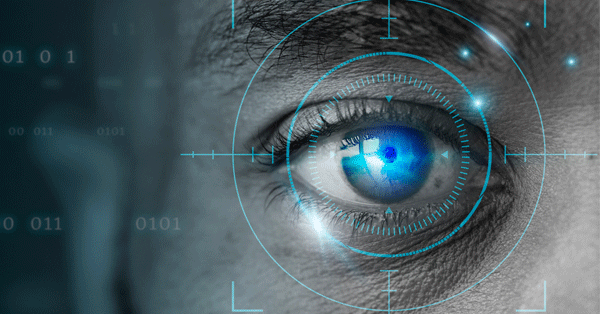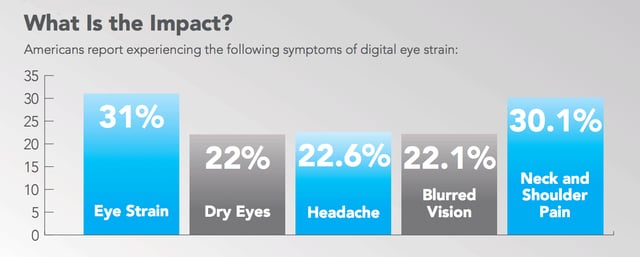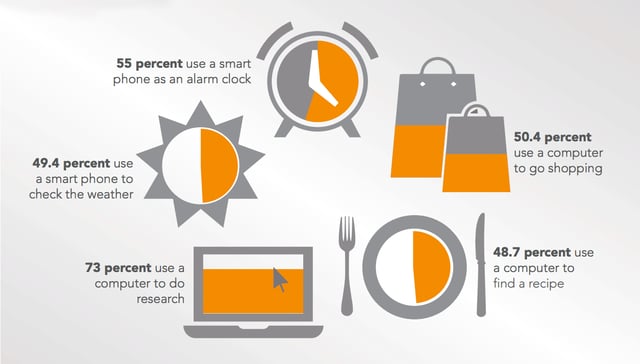Tips for Selling Anti-Fatigue Lenses for Digital Eye Strain

Keeping up with the latest trends in optical sales can be tricky. Should you continue to focus on baby boomers, who as recently as 2015 were responsible for as much as half the revenue of retailers? What about the nation’s 77 million millennials? Should you focus your attention on their optical needs?
Well, if the trade magazines and advertisers are correct, the answer is a resounding, “Yes!” Everywhere you look, there are warnings about digital eye strain, articles on the dangers of high-energy visible (HEV) light, and new product launches for lenses that protect us from such new threats.
And, it makes sense when you think about it. Today’s generation spends more time than ever exposing their eyes to all kinds of digital screens, in addition to sunlight exposure.
What is Digital Eye Strain?
Digital eye strain is the temporary discomfort that follows two or more hours of digital device use. Electronic devices like televisions, computers, smart phones and tablets can cause digital eye strain, especially when they are used simultaneously or when switching repeatedly from one device to another. Symptoms of digital eye strain include:
- Red, dry, or irritated eyes
- Blurred vision/double vision
- Eye fatigue/strain
- Back, neck, and shoulder pain
- Headaches
The American Optometric Association (AOA) reports the most frequent health complaints among computer workers are vision-related. Studies indicate that 50 to 90 percent of computer users suffer from visual symptoms of digital eye strain or computer vision syndrome.
Digital devices often feature small print and pixelated images that can be difficult to read and cause our eyes to strain in order to focus. People may also be using the devices improperly by holding them at the wrong angle or too far from our eyes. Blue light (HEV), is another cause of digital eye strain. It is emitted by digital devices and increases eye strain more so than other colors that have a longer wavelength. It may also contribute to vision problems such as cataracts and age-related macular degeneration. Digital eye strain can also be exacerbated in adults who wear prescription eyewear because their corrective lenses are not intended for viewing the mid-distance range of computers and electronics.
The New Statistics
The Vision Council has released the 2017 Blue Light/Digital Eye Strain Report, which captures some interesting statistics about this skyrocketing market space.
In the report, we find that more than 87% of Americans use digital devices for more than 2 hours per day, and 52.2% use two digital devices simultaneously. As a result, they are experiencing the following symptoms of digital eye strain:
Americans are becoming increasingly digitized, with more of our daily tasks moving online:
Digital eye strain is becoming a family affair, affecting all age groups. The following results are for people using digital devices for more than two hours per day:
Effects on Children
There are also some important statistics regarding the effects of digital eye strain on our children:
- 5% of Americans report their children get more than two hours of screen time per day
- 6% report their children are experiencing one of the following after being exposed to more than two hours of screen time:
- Headaches
- Neck/shoulder pain
- Eye strain, dry or irritated eyes
- Reduced attention span
- Poor behavior
- Irritability
The report also shows that 78.3% of parents are somewhat or very concerned about the impact of digital devices on their children. Of them, only 29.1% report taking their children for an annual eye exam as part of back-to-school preparation.
What Can Be Done to Reduce Digital Eye Strain?
The report also reveals that 68.5% of Americans have not discussed their digital device usage with their eyecare provider, and 73.5% report they did not know eyewear can be used to protect the eyes from the short- and long-term effects of digital eye strain, as well as blue light exposure.
Too bad too, because there is a growing list of lens solutions for such a growing problem. Here’s a quick look at a three solutions in the rapidly growing segment of single vision lenses that help address digital eye strain.
1) Essilor Eyezen+ Lenses
These lenses are designed to address the issues affecting the modern digital device user and provide them with a more comfortable vision experience. They contain a small amount of accommodative relief to alleviate eye strain caused by digital devices for long periods of time. They also utilize the Smart Blue Filter™ feature to reduce exposure to harmful Blue Light.
There are three unique Eyezen+ designs, recommended for certain age groups:
- Eyezen+ 1 – patients age 18 to 34 (0.4 diopters)
- Eyezen+ 2 – patients age 35 to 44 (0.6 diopters)
- Eyezen+ 3 – patients age 45 to 50 (0.85 diopters)*
*It is recommended Eyecare Professionals consider progressive lenses for their patients age 45+.
Eyezen+ Lenses are fitted, ordered, and dispensed just like any single vision lens, with the exception of a required fitting height measurement when placing an order. To acquire the fitting height, simply measure from center pupil to the lowest point of the lens.
2) Shamir Relax
This lens has a slight add power in the lower part of the lens. It’s a small enough amount to allow for clear distance vision, but enough power to relieve eye strain. Since the power is so slight, it’s a good replacement for your patients’ standard single-vision lenses. And, because it’s a freeform lens, it provides a fatigue-relief solution without distortion or swim.
By utilizing Shamir Relax, your patients’ lens accommodations will be reduced by up to 30%. These are recommended for all your single-vision wearers and pre-presbyopic patients, and even non-prescription patients who have symptoms of digital eye strain. Recommended minimum fitting height is 16mm.
Selling Tips
There are certainly enough products on the market for you and your practice to meet the growing needs this digital revolution has created. There are more and more people becoming aware of their need to protect their eyes, and how lenses can help ease their eye fatigue at the end of the day.
So, how do you make your patients aware of the solutions you offer? Here are a few tips gathered from other eye doctors:
- Ahead of their appointment, send patients links to educational content on your website.
- Include this information in your monthly newsletter and on signage in your practice.
- Have video presentations playing in your practice, or be able to play educational videos for your patients.
- Talk to your patients in the chair about eye strain and solutions you offer (remember, 73.5% report they did not know eyewear can be used to protect the eyes).
- Ask your parents about their childrens' habits with digital devices and offer solutions. One doctor reports he has prescribed over 400 anti-fatigue lenses to patients and only 10-15 have rejected them.
- Suggest secondary eyewear with extra protection for patients who spend a lot of time behind digital devices.
